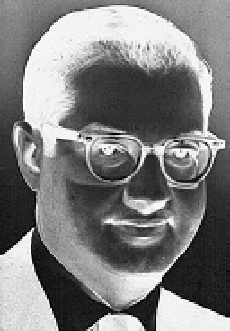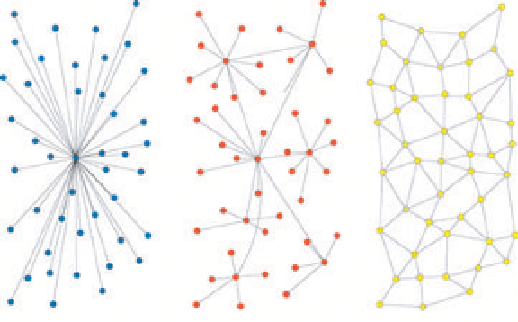Information Technology Reference
In-Depth Information
Fig. 10.9. A figure from Paul Baran's original paper on packet switching shows examples of cen-
tralized, decentralized, and distributed networks. The distributed network is also called a “fishnet”
network, and its most important feature is the lack of centralization so that all nodes have an equal
importance. This fishnet architecture also contains a certain level of redundancy because each node
is connected to several other nodes. This redundancy allows multiple paths for the message packets
to reach their destination. This provides the network with much more robustness and reliability
than a centralized network with a single path to the destination node.
In the early 1950s, Warren McCulloch, a neurophysiologist at MIT, had
been talking with John von Neumann and others about the brain and its net-
work of
neurons
(nerve cells in the brain). Together with the mathematician
Walter Pitts, McCulloch developed a mathematical model of a neuron and
linked these model neurons together to form an artificial “neural network”
(see
Chapter 13
). This network was a computer program that operated much
like the connected nerve cells in the nervous system. Baran knew of this work
and was influenced by McCulloch's ideas of neural networks:
Warren McCulloch in particular inspired me. He described how he could
excise a part of the brain, and the function in that part would move over to
another part. . . . McCulloch's version of the brain had the characteristics I felt
would be important in designing a really reliable communication system.
7
At the time, the telephone system depended on a hierarchical system in which
switching centers ranked one above the other. Baran had analyzed what would
happen to the telephone network after a nuclear attack on U.S. military targets,
and his results showed that the system was very vulnerable to even the inciden-
tal, “collateral” damage caused by such an attack. In designing a more robust
system, Baran introduced what he called “redundancy” - that is, exceeding
what is necessary - into the network, by allowing multiple pathways between
the different centers. He advocated building a distributed network that looked
rather like a fishnet (
Fig. 10.9
). A network with only one link connecting each
center has a redundancy level of one and is obviously extremely vulnerable to
disruption. Baran's calculations showed that “just a redundancy level of maybe
three or four would permit almost as robust a network as the theoretical limit.”
8
This meant that even if some links in the network were destroyed in a nuclear
attack, because each center was connected to three or four other centers it
would still be possible to find working paths through the network.
B.10.7. Paul Baran (1926-2011)
pioneered the concept of distributed
networks and packet switching for
reliable communications after a
nuclear strike. He was never able to
persuade AT&T engineers to build
even a prototype of his packet-
switching system.


Search WWH ::

Custom Search